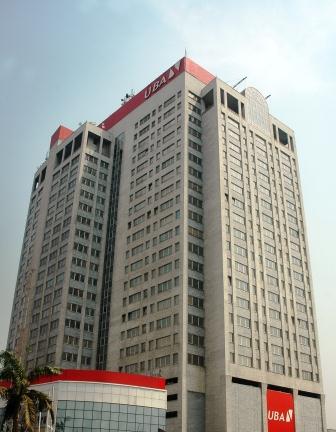During bearish markets, all assets often
look cheap but it is important to look at the fundamentals of companies to
understand the assets that are really cheap. This article aims at showcasing
one of the assets that are really cheap on the Nigerian Stock Exchange, thus
offering astute value investors the opportunity to take “early bird” advantage
of the low valuation before the general market realizes the value in the stock.
look cheap but it is important to look at the fundamentals of companies to
understand the assets that are really cheap. This article aims at showcasing
one of the assets that are really cheap on the Nigerian Stock Exchange, thus
offering astute value investors the opportunity to take “early bird” advantage
of the low valuation before the general market realizes the value in the stock.
Trading at 2.5x 2015e earnings and 0.53x
P/BV, UBA is wrongly priced at a 50% discount to peer average valuation despite the
strong 24.8% annualized return on average equity (RoAE) in the first quarter of
the year. Even as average analysts’ 2015e PAT forecast ofN60 billion discounts the strong start to the year (given the
impact of macroeconomic pressure on banks’ earnings), it implies analysts’
confidence in UBA’s ability to deliver a 20% RoAE, as guided by the Management.
Ranking in the top-3 bracket of the Nigerian banking sector in market share and
ROaE, UBA is a wrongly priced asset. Given its discounted valuation and most analysts’
expectation ofN0.50 dividend in the
year (12% dividend yield), the counter has a compelling investment case for
both growth/value and income investors.
P/BV, UBA is wrongly priced at a 50% discount to peer average valuation despite the
strong 24.8% annualized return on average equity (RoAE) in the first quarter of
the year. Even as average analysts’ 2015e PAT forecast of
impact of macroeconomic pressure on banks’ earnings), it implies analysts’
confidence in UBA’s ability to deliver a 20% RoAE, as guided by the Management.
Ranking in the top-3 bracket of the Nigerian banking sector in market share and
ROaE, UBA is a wrongly priced asset. Given its discounted valuation and most analysts’
expectation of
year (12% dividend yield), the counter has a compelling investment case for
both growth/value and income investors.
Whilst UBA is not entirely immune to the
macroeconomic and regulatory pressures, it appears less vulnerable,
particularly when viewed from the perspective of its strong balance sheet
liquidity, less exposure to volatile segments of the market and overall asset
quality. More so, after the long haul, its eighteen African subsidiaries are
now waxing strong, with almost a quarter contribution to the Group’s earnings;
a diversification benefit which no other Nigerian bank enjoys. Should UBA deliver
analysts earnings expectation ofN60
billion by year-end; a 27% year-on-year growth, implyingN1.68 Earnings per Share, the stock should see appreciable rally.
Interestingly, the Board continues to improve on the reporting and transparency
of the Bank, with a new milestone of auditing the half year results before
releasing to the public – a development which though delayed a few banks’ half
year earnings release but good for market confidence. Analysts continue to
speculate on UBA’s likely initiation of interim dividend, with an average
expectation ofN0.20/share or 4.8%
interim dividend yield when the result is released in the early week of
September, as Management guided.
macroeconomic and regulatory pressures, it appears less vulnerable,
particularly when viewed from the perspective of its strong balance sheet
liquidity, less exposure to volatile segments of the market and overall asset
quality. More so, after the long haul, its eighteen African subsidiaries are
now waxing strong, with almost a quarter contribution to the Group’s earnings;
a diversification benefit which no other Nigerian bank enjoys. Should UBA deliver
analysts earnings expectation of
billion by year-end; a 27% year-on-year growth, implying
Interestingly, the Board continues to improve on the reporting and transparency
of the Bank, with a new milestone of auditing the half year results before
releasing to the public – a development which though delayed a few banks’ half
year earnings release but good for market confidence. Analysts continue to
speculate on UBA’s likely initiation of interim dividend, with an average
expectation of
interim dividend yield when the result is released in the early week of
September, as Management guided.
Re-pricing assets and targeting higher
share of customers wallet:
The attraction to UBA is more compelling when put in the perspective of
Management’s strategy on exploring latent pricing and volume upsides. Taking
advantage of the higher interest rate environment and tight monetary policy,
the Bank embarked on loan re-pricing in the first half of the year, with the
benefit of negotiating increased transaction banking volumes from its
customers. The increased drive of UBA sales force may be unconnected to recent
Management disclosure on its strategic initiatives around increasing the share
of wallet of its approximately 9 million customers across the African
continent. This reinvigorated drive for earnings growth may help UBA achieve
Management’s target of sustaining the improvement in net interest margin, as
reflected in the 2015Q1 unaudited results. Interestingly, the relatively tight
liquidity environment orchestrated by the 31% harmonized cash reserve requirement
should have less impact on UBA, given its net credit from the CBN when the
policy was implemented in May.
share of customers wallet:
The attraction to UBA is more compelling when put in the perspective of
Management’s strategy on exploring latent pricing and volume upsides. Taking
advantage of the higher interest rate environment and tight monetary policy,
the Bank embarked on loan re-pricing in the first half of the year, with the
benefit of negotiating increased transaction banking volumes from its
customers. The increased drive of UBA sales force may be unconnected to recent
Management disclosure on its strategic initiatives around increasing the share
of wallet of its approximately 9 million customers across the African
continent. This reinvigorated drive for earnings growth may help UBA achieve
Management’s target of sustaining the improvement in net interest margin, as
reflected in the 2015Q1 unaudited results. Interestingly, the relatively tight
liquidity environment orchestrated by the 31% harmonized cash reserve requirement
should have less impact on UBA, given its net credit from the CBN when the
policy was implemented in May.
More so, UBA is a net placer of funds at
the interbank market, thus it should take good advantage of higher NIBOR (rates
at which banks lends to themselves in Nigeria) to grow its interest income
line. More so, UBA Management seems more than ever committed to continuous
improvement in its internal operations to ensure the efficiency of its service
channels supports higher pricing strategy and volume drive. Even as UBA has
overhauled its alternative service channels, particularly online banking,
U-Direct, which is now ranked as one of the best online banking platform, it
may have to further invest in the ambiance of its branches and other customer
service related offerings to achieve its salient target of growing market share
in the increasingly competitive market environment.
the interbank market, thus it should take good advantage of higher NIBOR (rates
at which banks lends to themselves in Nigeria) to grow its interest income
line. More so, UBA Management seems more than ever committed to continuous
improvement in its internal operations to ensure the efficiency of its service
channels supports higher pricing strategy and volume drive. Even as UBA has
overhauled its alternative service channels, particularly online banking,
U-Direct, which is now ranked as one of the best online banking platform, it
may have to further invest in the ambiance of its branches and other customer
service related offerings to achieve its salient target of growing market share
in the increasingly competitive market environment.
Africa – after the long haul, the fruits
are finally ripe: The
harvest season may be near for UBA’s African businesses, with Management
disclosure of almost a quarter earnings contribution and prospect for a steady
ramp up as Management addresses the knotty issues in these markets on a case by
case basis. Notably, the Ghana, Senegal and Cameroon businesses have become
benchmarks in their respective countries of operation, with strong
profitability and growth. Even as Management recently noted its long- battled
challenge in East Africa, with particular mention of Kenya, where UBA is still
loss making, Management expects all subsidiaries to have positive earnings
contribution to the Group from 2016, as Kenya (the most challenging country for
UBA) sets to break even by the end of 2015. Even as Management may be too
bullish on potential earnings contribution from Africa (ex-Nigeria), recent
momentum suggests that UBA may see at least 30% of its earnings from Africa by
2020, as the African business grow faster than the Nigerian business, given
their relatively small size.
are finally ripe: The
harvest season may be near for UBA’s African businesses, with Management
disclosure of almost a quarter earnings contribution and prospect for a steady
ramp up as Management addresses the knotty issues in these markets on a case by
case basis. Notably, the Ghana, Senegal and Cameroon businesses have become
benchmarks in their respective countries of operation, with strong
profitability and growth. Even as Management recently noted its long- battled
challenge in East Africa, with particular mention of Kenya, where UBA is still
loss making, Management expects all subsidiaries to have positive earnings
contribution to the Group from 2016, as Kenya (the most challenging country for
UBA) sets to break even by the end of 2015. Even as Management may be too
bullish on potential earnings contribution from Africa (ex-Nigeria), recent
momentum suggests that UBA may see at least 30% of its earnings from Africa by
2020, as the African business grow faster than the Nigerian business, given
their relatively small size.
Can Management achieve its target on loan
and deposit growth? At
its 16th April, 2015 conference call to analysts and investors, the Management
of UBA guided on 15% to 20% loan and deposit growth rates in the year. Whilst
the 2015 Q1 growth of 7% in loan book and 6% in deposit base suggest the
ability of Management to deliver on these KPIs, the recent macroeconomic
developments may undermine Management efforts to achieve this target by
year-end. Interestingly, Management’s target was partly based on its ability to
ramp up balance growth in the second half of the year, on expectation that the
new government will kick-off very strongly with clear fiscal direction and
quick wins on tactical reforms in key sectors of the economy. Given the
realities on the ground, Management may have been more cautious in its lending
appetite as seen with most other banks, which made similar assumptions when
providing 2015 targets to investors and analysts. Hopefully, UBA Management
will provide more guidance on its ability to deliver on these targets at its
expected conference call after the release of audited half year result in
September.
and deposit growth? At
its 16th April, 2015 conference call to analysts and investors, the Management
of UBA guided on 15% to 20% loan and deposit growth rates in the year. Whilst
the 2015 Q1 growth of 7% in loan book and 6% in deposit base suggest the
ability of Management to deliver on these KPIs, the recent macroeconomic
developments may undermine Management efforts to achieve this target by
year-end. Interestingly, Management’s target was partly based on its ability to
ramp up balance growth in the second half of the year, on expectation that the
new government will kick-off very strongly with clear fiscal direction and
quick wins on tactical reforms in key sectors of the economy. Given the
realities on the ground, Management may have been more cautious in its lending
appetite as seen with most other banks, which made similar assumptions when
providing 2015 targets to investors and analysts. Hopefully, UBA Management
will provide more guidance on its ability to deliver on these targets at its
expected conference call after the release of audited half year result in
September.




























